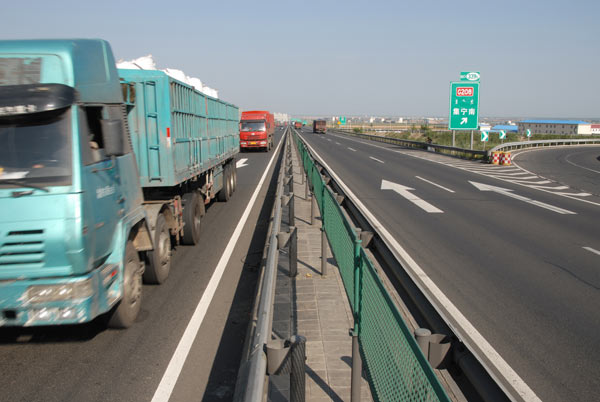-
News >China
Measures put traffic jam on the road to clearance
2010-09-06 07:16BEIJING - The monster traffic jam on the Beijing-Tibet highway was greatly eased on Sunday after a number of emergency measures were introduced and cross-regional coordination enhanced by the Ministry of Public Security.
However, experts said the jam was likely to reoccur in the near future as the root cause of the problem - huge transportation demand on limited road capacity - remained.

Traffic is brought back to normal on Sunday in the Inner Mongolia section of the Beijing-Tibet highway after more than 10 days of congestion. [Liu Kai / For China Daily]Apart from an 8-km section between the Inner Mongolia autonomous region and Hebei province, traffic was back to normal on sections that had been jammed for the past month, according to Xinhua News Agency on Sunday.
On Saturday, the Ministry of Public Security ordered traffic control departments in Beijing, Hebei and Inner Mongolia to establish a coordination center to tackle the jam.
The center will oversee the situation, release information and take measures to divert traffic flow if necessary, according to a statement released by the ministry on Saturday.In addition, the center will work with road administration and health authorities to help deal with accidents and breakdowns. It will also join hands with civil affairs departments to ensure food and drink supplies as well as medical services to stranded drivers, the statement said.
The Beijing-Tibet highway, with a designed length of 3,700 km, will link Beijing to Lhasa of Southwest China's Tibet autonomous region once it is completed.
At present, the Beijing-Xining section is open to traffic and the Xining-Lhasa section is still under planning and construction. Currently, it is the only highway to Beijing and Tianjin from the northwest.
The recent traffic jam occurred mainly in the Hebei and Inner Mongolia sections once maintenance work began on a parallel route earlier this summer.
Poor road design and overloaded trucks were to blame, Fu Zhenhua, director of the Beijing Public Security Bureau, was quoted as saying in a statement from the Ministry of Public Security.
Four highways - Beijing-Tibet, National Road 110, Xiguan road and Beijing-Xinjiang - all converge into the last one, which creates a huge bottleneck, according to a Beijing News report.
As well as this, the flourishing coal industry in the Inner Mongolia autonomous region also puts pressure on transportation.
"Most of the stranded vehicles are cargo trucks, and more than 95 percent of them are fully-loaded with coal from Inner Mongolia," said Hao Zhilei, a traffic police official in Beijing.
Zhang Peng, a driver who transported coal from Erdos in Inner Mongolia to Beijing, said drivers did not go on other routes, such as through Shanxi province, because they would have to drive 200 km more and pay extra highway fees and fines for overloading. "So I would rather have traffic jams here," he said.
Figures from the Ministry of Public Security show that since June, up to 20,000 trucks were entering Beijing daily through the Beijing-Tibet highway, double the designed capacity.
Meanwhile, Hebei and Beijing have put up roadblocks on their section of the Beijing-Tibet highway to limit the number of large trucks entering the capital, according to the ministry.
However, the action may result in a chain reaction: the slow moving of vehicles to Beijing causes traffic jams in Hebei, which in turn can cause congestion in Inner Mongolia.
Therefore, experts said the current easing of traffic on the highway would only be temporary and the final solution was to optimize road and railway networks.
"The root of the problem is that transportation network planning and construction lag behind demand," said Li Heren, vice-chairman of the China Association of Communication Enterprise Management.
He said the traffic pressure near Beijing would be relieved when the highway connecting Zhangjiakou and Shijiazhuang in Hebei opened to traffic in 2012.
However, Zhang Fusheng, general manager of the Inner Mongolia Electric Power Corporation, said if the country's economy still depended heavily on coal from Inner Mongolia, the cause of the jam on the Beijing-Tibet highway would be hard to solve permanently.
"The Hohhot railway station could only satisfy 35 percent of transportation demands, so most of the coal could only be transported by trucks," he was quoted by Xinhua as saying.
"We should consider the total coal output and the rail and road transportation capacity, or convert the coal into electricity locally and then send the energy to other parts of the country," he said.
Gao Jie, a researcher with the China Academy of Transportation Sciences, proposed a special railway be built to transport coal from Inner Mongolia, adding that railway was still the most efficient and environmentally friendly way for energy transportation.
Gao also said high toll fees and arbitrary charges in some sections encouraged drivers to overload as they sought razor-thin profits, which consequently result in poor road conditions.
Zhao Yinan contributed to this story.
